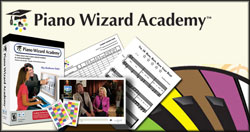Why are scales and arpeggios so important? Since the vast majority of Western music is based upon major/minor tonality, having a mastery of scales and arpeggios is like knowing your addition, subtraction, multiplication and division tables in order to do math. Also, it provides an opportunity to focus purely on finger technique. It is an extraction of just that element of playing without the complexity of harmony, rhythm, phrasing and expression. Scales and arpeggios also provide an excellent warm-up for your practice.
What are scales and arpeggios? Scales are a series of 8 whole steps and half steps (and augmented seconds found in harmonic minor scales) in which the first and last notes are the same. Arpeggios are broken chords. Generally scales and arpeggios are practiced throughout a wide range of an instrument repeating the pattern from octave to octave both ascending and descending.
So, what is a good way to practice scales and arpeggios on the piano? First, you must learn the fingering for all the major and minor scales and arpeggios. Fortunately, Hanon 60 Exercises for the Virtuoso Pianist contains the standard fingering for all scales and arpeggios in 4 octaves (which is how you should play them). Unlike some instruments like violin and other string instruments, the fingering for scales and arpeggios is standard for the piano with almost no exceptions. (Mirror fingering is one such exception in which the thumb plays the same notes in each hand in all scales and arpeggios, but this utilized by a tiny fraction of pianists.)
If you have never studied any scales or arpeggios, it is best to master one scale, say C major or G major before going on to other scales. Fortunately the fingering pattern is the same for C, G, D, A and E major scales. So once you learn C major, you will get a lot of mileage out of your work! Essentially there are 2 fingerings to learn for each hand in both ascending and descending. While the hands each play the same fingering on the same notes going up and down the scale, you will need to focus on the fingers that cross. Going up in the right hand you have thumb crossings, coming down you have 3rd and 4th finger crossings. Because your hands are backwards from one another, the left hand has 3rd and 4th finger crossings going up and thumb crossings going down. Arpeggios only have one thumb crossing and one 3rd or 4th finger crossing in each hand. You may need to practice hands separately in order to get comfortable with the fingering.
It is important to practice scales and arpeggios slowly. There are several reasons for this:
● It gives you an opportunity to study your hand positions and the shape of your fingers.
● You can be precise in timing and intensity and make sure the hands are playing precisely together.
● It develops strength by stretching as in dance or yoga exercises.
● It develops strength in the upward motion of the fingers essential for consistency of length of notes.
You should practice scales and arpeggios with the metronome at all times. Begin by playing 1 note to the beat at 60 beats per minute. In the right hand going up (and the left hand going down) be sure to prepare the thumb by keeping it tucked under your hand so it is ready to play well in advance. Play with raised, rounded fingers and use ample finger power, not arm strength since there will not be sufficient time to utilize the arms once you increase the speed. After you have played the scale comfortably 4 times in a row at 1 note to the beat, increase the speed to 2 notes to the beat. Continue the same way. When you are comfortable and have played the scale at least 4 times in a row at 2 notes to the beat, you may try 4 notes to the beat. Be sure to lighten up and stay close to the keys since there isn't time to raise the fingers at this speed. If you have any difficulty in achieving 4 notes to the beat, lower the metronome to a speed you are comfortable playing the scale many times until fluid. Then increase the metronome 1 notch at a time until you achieve 60 at 4 notes to the beat comfortably many times in a row.


